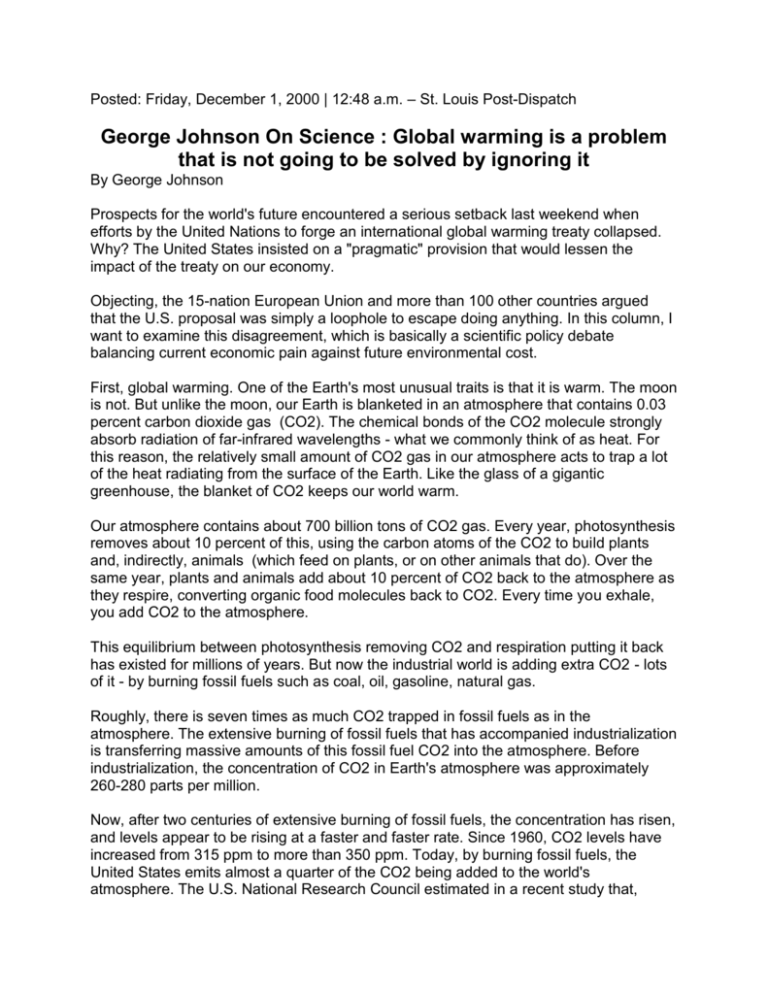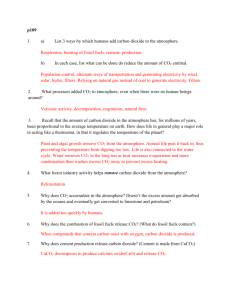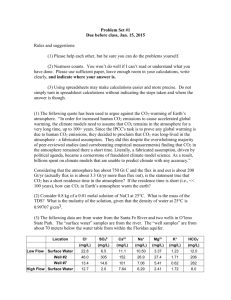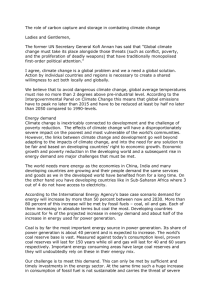Posted: Friday, December 1, 2000 | 12:48 a
advertisement

Posted: Friday, December 1, 2000 | 12:48 a.m. – St. Louis Post-Dispatch George Johnson On Science : Global warming is a problem that is not going to be solved by ignoring it By George Johnson Prospects for the world's future encountered a serious setback last weekend when efforts by the United Nations to forge an international global warming treaty collapsed. Why? The United States insisted on a "pragmatic" provision that would lessen the impact of the treaty on our economy. Objecting, the 15-nation European Union and more than 100 other countries argued that the U.S. proposal was simply a loophole to escape doing anything. In this column, I want to examine this disagreement, which is basically a scientific policy debate balancing current economic pain against future environmental cost. First, global warming. One of the Earth's most unusual traits is that it is warm. The moon is not. But unlike the moon, our Earth is blanketed in an atmosphere that contains 0.03 percent carbon dioxide gas (CO2). The chemical bonds of the CO2 molecule strongly absorb radiation of far-infrared wavelengths - what we commonly think of as heat. For this reason, the relatively small amount of CO2 gas in our atmosphere acts to trap a lot of the heat radiating from the surface of the Earth. Like the glass of a gigantic greenhouse, the blanket of CO2 keeps our world warm. Our atmosphere contains about 700 billion tons of CO2 gas. Every year, photosynthesis removes about 10 percent of this, using the carbon atoms of the CO2 to build plants and, indirectly, animals (which feed on plants, or on other animals that do). Over the same year, plants and animals add about 10 percent of CO2 back to the atmosphere as they respire, converting organic food molecules back to CO2. Every time you exhale, you add CO2 to the atmosphere. This equilibrium between photosynthesis removing CO2 and respiration putting it back has existed for millions of years. But now the industrial world is adding extra CO2 - lots of it - by burning fossil fuels such as coal, oil, gasoline, natural gas. Roughly, there is seven times as much CO2 trapped in fossil fuels as in the atmosphere. The extensive burning of fossil fuels that has accompanied industrialization is transferring massive amounts of this fossil fuel CO2 into the atmosphere. Before industrialization, the concentration of CO2 in Earth's atmosphere was approximately 260-280 parts per million. Now, after two centuries of extensive burning of fossil fuels, the concentration has risen, and levels appear to be rising at a faster and faster rate. Since 1960, CO2 levels have increased from 315 ppm to more than 350 ppm. Today, by burning fossil fuels, the United States emits almost a quarter of the CO2 being added to the world's atmosphere. The U.S. National Research Council estimated in a recent study that, unchecked, world CO2 levels would pass 600 ppm (almost double current levels) as soon as 2035. As CO2 levels have risen, so too has the average mean global temperature - about 1 degree Celsius since 1900. This may not seem a lot, but it has been enough to raise sea levels 5 centimeters. Scientists estimate the Earth's temperature could rise by up to 6 degrees Celsius (10.8 degrees Fahrenheit) by 2100. If the climate becomes so warm that the polar ice cap melts (and there is considerable recent evidence of this), sea levels will rise by more than almost 500 feet, flooding the entire Atlantic coast of North America for an average of over 100 hundred miles inland. Responding to this very real threat, some 170 countries signed the Kyoto Protocol in 1997. This agreement set targets to curb emissions of CO2 from fossil fuels by 36 industrial countries. The goal was a 5.2 percent reduction from 1990 levels by 2012. The two-week U.N.-sponsored meeting that ended Saturday was supposed to set the rules for countries to meet this target. Now you might think this a straightforward agenda - just everybody reduce the burning of fossil fuels by 5.2 percent, but it isn't. In a nutshell, the problem is that cutting back on burning fossil fuels risks dampening the current U.S. economic boom, as it would almost certainly make energy more expensive. Also, taking direct action to cut emissions by penalizing the wasteful energy habits of average Americans like you and me would not be particularly popular. So the United States made what it dubbed a "pragmatic" proposal. U.S. forest and agricultural lands that absorb CO2 by photosynthesis (so-called carbon sinks) should be credited for their contribution to reducing atmospheric CO2 levels. This would reduce the U.S. target by quite a bit. Combined with clever mechanisms for trading emission credits with other countries, the U.S. carbon sink proposal would allow the United States to reach half its target without taking any significant action at all. European countries objected strongly, as did much of the rest of the world. They saw our proposal simply as the United States avoiding doing anything. So where's the right here? It seems to me we must find some way to really reduce CO2 emissions, however painful the adjustment. The alternative leaves our children a world we would not want to live in. There isn't a third option. Next year, the world will get together again and attempt another agreement. We should try harder to reach one. The price of not doing so is just too high. onscience@txtwriter.com \http://txtwriter.com \George Johnson is a biology professor at Washington University.\postnet.com/links: Read more about global warming.









